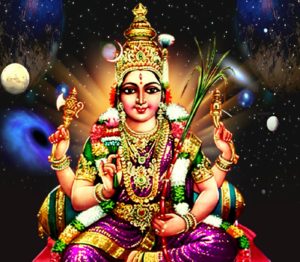Introduction to Lalitha Sahasranama
The term ‘Sahasranama’ is of Sanskrit origin and means ‘the Thousand names.’ Hinduism has several sacred texts praising the Gods and Goddesses, and Sahasranama is one of them. Saharanama contains praise in thousand different names of a God or Goddess. Therefore, there are different Sahasranamas for each God or Goddess.
Of the available Sahasranamas, Vishnu Sahasranama, Lalitha Sahasranama and Shiva Sahasranama are very popular. While some devotees recite Sahasranama daily, some recite it once a week or during auspicious days or festivals.
Lalitha Sahasranama praises the divine mother and lists a thousand names of her. ‘Lalitha’ itself is one of the important names of the Goddess. ‘Lalitha Tirupura Sundari’ is the supreme form of the divine mother, and thus this powerful Sahasranama is known by her name. A thousand names in Lalitha Sahasranama praises the qualities of the divine mother, each of the names is so powerful and full of divine vibrations.
The legends of Lalitha Sahasranama
As per the legends, Lalita Sahasranama was composed by the eight vaag devis (Vasini, Kameshvari, Aruna, Vimala, Jayani, Modini, Sarveshvari, and Kaulini) upon the directions of the Goddess Lalitha herself.
This stotra appears in the Brahmanda Purana, an ancient Hindu text, in the chapter of discussion between Lord Hayagriva and Sage Agastya. Lord Hayagriva, featuring the head of a horse, is one of the incarnations of Lord Maha Vishnu. He is worshipped as the God of Knowledge and was the one who retrieved the Vedas from Asuras who stole them. On the other hand, Sage Agastya is one of the saptharishis (the stars of the constellation Saptarishi).
Agastya wanted to know the thousand holiest names of Sri Lalita and did penance towards Lord Hayagriva to have them taught to him. Lord Hayagriva, satisfied at the penance, appeared before Sage Agastya and taught him these thousand names of the Goddess.
It is widely believed that the Lalithambigai temple at Thirumeyachur, near Myladuturai, is where Agastya was initiated into this sahasranama. An alternative belief is that the Upanishad Bramham Mutt located at Kanchipuram is where this initiation happened.
Why is Lalitha Sahasranama significant
Though there are many stortras dedicated to the Goddess, the Lalitha Sahasranama stands out. The following points make it significant.
- Of all the available Sahasranamas, it is the only one praising the Divine Mother.
- Other Sahasranamas originated at the Earth plane, but Lalitha Sahasranama originated in heaven itself.
- The divine mother herself asked the vaag devatas to sing in praise of her.
- It is one of the essential tantric literature.
- Regular chanting of Lalitha Sahasranama can relieve devotees of their life problems.
- Only the individuals having the grace of Goddess Sri Lalitha will be able to recite this Sahasranamam.
The construction of Lalitha Sahasra Naama
The thousand names of the Lalitha Sahasranama are classified into 10 groups. Below are the beginning name of each of ten centum:
1.Sri Maatha
2.Mani pooraantharuditha
3.Sadgathi prada
4.Hrimkaari
5.Vividhaakaara
6.Gudanna preetha maanasa
7.Daraondolitha deerkhaakshi
8.Desa kaala paricchinna
9.Pushta
10.Naadaroopini
It is important to note that no name is used for a second time with the same meaning; each name of the Goddess has a unique meaning.
Benefits of chanting the Lalitha Sahasranama stotram
Chanting Lalitha Sahasranama is believed to bestow several blessings upon the devotees. Some of the main advantages of chanting this powerful stotram are as follows.
- Chanting this stotra bestows the grace of divine mother upon you.
- Goddess Lalitha becomes happy when she listens to this stotram and blesses the person chanting with all good health and immense wealth.
- The grace of the Goddess will protect the one chanting and their family against all negatives.
- The Lalitha Sahasranama Stotram is the principal literature for those who follow the tantric philosophy. Chanting this stotra will help you understand the secrets of tantric philosophy effortlessly.
- The stotra safeguards the devotee against diseases and mishaps.
- It will protect you from the exploitation of tricksters.
- One who chants the Lalitha Sahasranama will gain divine wisdom and knowledge.
- Chanting this stotram will help you succeed both spiritually and materially.
- Fridays and Tuesdays are perfect for chanting this Stotram, and chanting on those days is believed to give long life to the life partners.
- Regular chanting of Sree Lalitha Sahasranama is as beneficial as visiting holy places, taking a dip in a sacred river, and donating food and materials.
- The malefic effects of planets will diminish if you chant this stotra regularly.
How to chant Lalitha Sahasranamam
There are two ways to chant the Lalitha Sahasranamam, either in the Stotra form and the mantra form.
If recited in Stotram form, all the Goddess’s thousand names are divided into stotrams containing a few names each and are recited collectively as a Stotra. In mantra form, each name of the Goddess is chanted individually, preceded by “Aum” and followed by “Namah.”
Navaratri and Lalitha Sahasranama
Navaratri is the festival of the Goddess, and chanting the Lalitha Sahasranama is very auspicious during this time. You can chant the entire Sahasranama daily for the nine days of Navaratri or may chant, hundred names each for ten days of the festival. For example, if you start it on the first day of Navaratri, you can complete chanting the entire Lalitha Sahasranama on Vijayadasami, the tenth day.
« 5 Strange Navratri Rituals We Bet You Didn’t Know About Secrets of Maha Navaratri: Fall 9 Nights of the Goddess »


